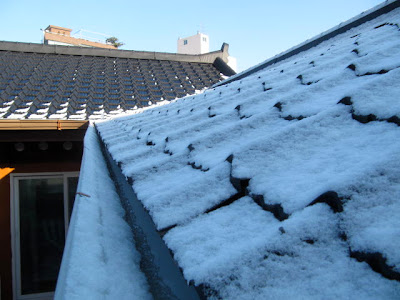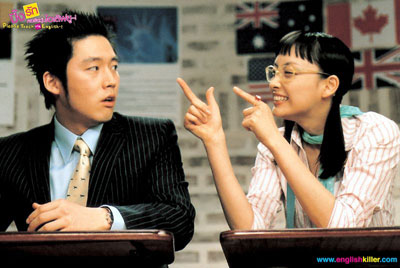My new license, with some obvious redactions
If you want to get your license in Korea, as long as you have your license from your own country, it's quite easy, as long as your country as approval of the Korea government (Click here for a list). You just need to exchnage your foreign license for a Korean license. The Korean government will hold on to your foreign license while you have the Korean license. If you want your foreign license back, you can just go to the office, with your plane ticket as proof that you will leave the country and you can get your license back.
First of all, you must go to your embassy and get some proof that your license is real. For US citizens like myself, that requires obtaining an affidavit which is $50.00 USD. Just as a tip, they don't accept most Korean debit cards so I had a rather hard time paying the bill. Either bring lots of cash with you, or a US credit card.
The entryway into the Driver's License Examination Office
You will need to bring
1. 3 passport sized photos (3cm x 4cm) (Can be obtained on the second floor in the Gangnam Branch for 6,000 won)
2. Your passport, showing your latest entry dates to Korea.
3. Your license and affidavit/proof of validity.
4. Your ARC (Alien Registration Card).
5. 10,000 won for processing
Gangnam Driver's License Examination Office
I was a little worried about knowing what I had to do when I arrived, but fortunately, it was quite straight forward. As soon as I entered, the "Changing Foreign License" desk was directly to my right. I had to fill out four forms, paste my photos to them and then the woman at the desk sent me off to get an eye exam in the basement.
"Changing Foreign License" desk
I thought that I had to take a writing exam, but when I brought my paperwork back to the desk she said that was all I had to do, and put my paperwork through. I talked to several people who got their license last year who had to do a written exam, but I found another person who got their license this year and apparently they didn't take any written exam either. Perhaps something has changed in the past year. But, just in case, I would look over the traffic signs just in case they make you take a test. The cost for the license processing was 6,000 won.
All in all, the process took less than an hour. It probably would have taken less time if I hadn't kept going to the examination desk asking if I needed to take a written exam and if I hadn't had to get my photos taken. It was amazingly fast. For your nearest Driver's License Examination Office, see here.
But, why get a Korean license rather than an international license, you ask? Well, an international license is generally only good for one year and then must be obtained again if you want to keep driving. The Korean license is good for 9 years and is recognized in a long list of countries, including the USA, so even if you go home for a short time, you can drive on your Korean license as well, plus in a long list of other countries if you happen to be traveling.
According to Korea4Expats, the Korean license is valid in the following countries:
Africa: Algeria, Angola, Botswana, Burundi, Burkina Faso, Cameroon, Central African Republic, Cape Verde, Cote d'lvoire, Republic of the Congo, Demoractic Republic of the Congo, Eritrea, Ethiopia, Guinea-Bissau, Equatorial Guinea, Gabon, Gambia, Ghana, Guinea, Lesotho, Liberia, Libya, Madagascar, Malawi, Mali, Morocco, Namibia, Niger, Nigeria, Rwanda, Republic of South Africa, San Tome and Principle, Senegal, Seychelles, Sierra Leone, Swaziland, Tanzania, Tunisia, Uganda, Zimbabwe
Americas: Barbados, Brazil, Canada, Chile, Colombia, Costa Rica, Grenada, Guatemala, Guyana, Nicaragua, the Dominican Republic, El Salvador, Haiti, Panama, Saint Lucia, Saint Vincent and the Grenadines, Uruguay
Asia: Afghanistan, Bhutan, Brunei, Cambodia, East Timor, Hong Kong, India, Indonesia, Japan, Laos, Malaysia, Maldives, Mongolia, Myanmar, Nepal, Pakistan, Papua New Guinea, Philippines, Samoa, Sri Lanka, Taiwan, Thailand, Tonga, Vietnam
Europe: Albania, Austria, Belgium, Bosnia and Herzegovina, Croatia, Cyprus, Czech Republic, Estonia, Finland, France, Georgia, Germany, Greece, Hungary, Iceland, Ireland, Italy, Kazakhstan, Liechtenstein, Luxembourg, the Netherlands, Moldova, Poland, Portugal, Russia, Romania, San Marino, Serbia and Montenegro, Slovakia, Switzerland, Spain, Tajikistan, Turkey, Turkmenistan, Ukraine, Uzbekistan, the United Kingdom
Middle East: Bahrain, Jordan, Kuwait, Lebanon, Oman, Qatar, Sudan, the United Arab Emirates, Yemen
If that's not enough reason for you to get your Korean license, I don't know what is.
**Update 12/31/2012**
Just got the following update from the US Embassy newsletter for January 2013:
Please be advised that starting January 1, 2013, the U.S. Embassy will no longer provide notary certifications for U.S. issued driver licenses. Republic of Korea is a member of the Hague Conference on Private International Law and recognizes apostilles issued by foreign authorities. To have your driver’s license apostilled, please contact the issuing state’s office of authentication for an apostille.
For more information, please visit the Korean Driver’s License Agency’s website. Please note that you must take a written exam before you can obtain a Korean driver’s license except for those who hold driver licenses that were issued by a State that has a reciprocity agreement with Korea; namely Alabama, Florida, Iowa, Maryland, Massachusetts, Michigan, Texas, Virginia, Washington, DC., and West Virginia. This written exam can be provided in English.
For more information on how to obtain a Korean driver’s license, please visit the Korean Driver's License Agency's Website.
... This explains the fact that I didn't need a test, and also suggests you will now need to obtain an official apositille rather than an affidavit. Check with the embassy website for more details and current information.






























































